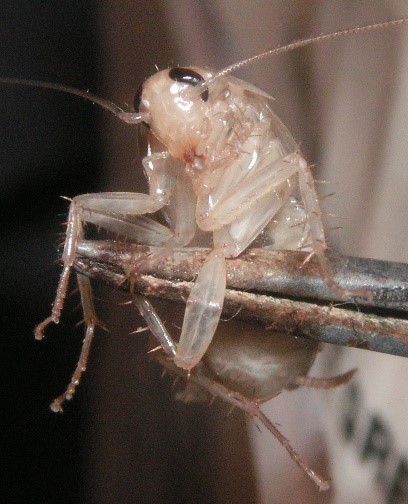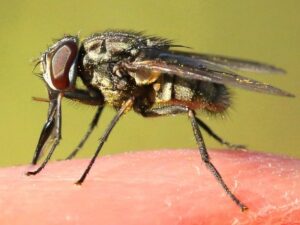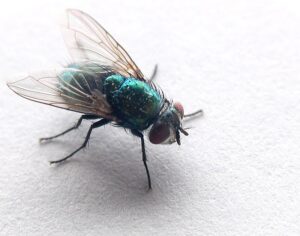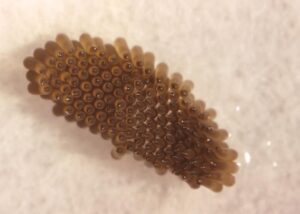German Cockroach:
General Description
Adult
- About 1.25 cm long.
- Grayish-tan or light brown in color, females darker than males.
- Two black longitudinal stripes on the pronotum.
- Wings cover the tip of the abdomen.
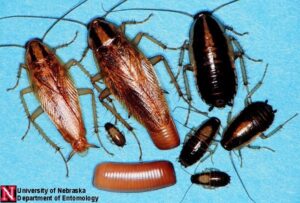
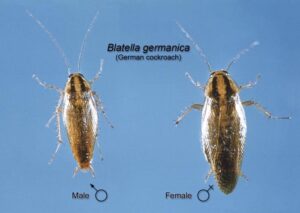
Nymph
- Smaller than adults (size depends on how many molts they have been through).
- Brownish-black with a pale tan stripe down the middle of the back.
- Wingless.
Life Cycle and Common Characteristics:
- German cockroaches are one of the most important urban insects, and the most common cockroach species in houses, apartments, restaurants, and hotels.
- They are most commonly found in food preparation areas, where moist, warm harborage sites are available. They can also be found in dishwasher rooms, gym locker rooms, or anywhere warmth, moisture, and food are available.
- Adult females have a higher reproductive capacity and allowing populations to increase quickly if unchecked.
- Adult females produce a high number of capsules (4-8) in their lifetime.
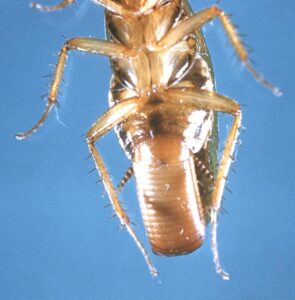
- Large number (30-48) of eggs are produced per capsule/ootheca.
- There are six or seven nymphal stages, called instars, before the molt or ecdysis into the adult stage.
- The nymphal stage requires 40-125 days to complete.
- The high rate of nymph survival due to small size, makes nymphs more concealed and protected.
- A German cockroach who undergo the molt, it is teneral until its cuticle hardens within 1-3 hours during which it will darken in color.
- The German cockroach has a short period of development from egg to adult (as short as 36 days under ideal conditions).
- Adults live up to a year, but most will die from various causes long before that time.
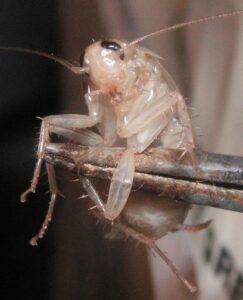 Nymphs have habits similar to those of adults, and they are active at night.
Nymphs have habits similar to those of adults, and they are active at night.- German cockroaches hide and food, where they forage at night, sightings of several German cockroaches during the day may indicate that populations are large and stressed for food or harborage.
- They feed on a variety of foods, and adults can survive up to one month without food. They are more dependent on water and die in one or two weeks if moisture is not available.
- German cockroaches generally prefer to forage within several feet of their harborage areas, but can be much more mobile in some circumstances.
- Adult males and non-gravid females are the most mobile stages and can move from the main harborage to other areas of a structure, particularly when crowding occurs.
- They are also readily transported unintentionally by humans in shopping bags, bags of produce, cardboard cartons, furniture, purses, book bags, and other items.
Damage and Medical Implications
- Cockroaches can be detected by their obnoxious odor or damage, or by the fecal matter (called frass) that they produce or deposit. These clues can aid in diagnosing a cockroach problem.
- Cockroaches are unlikely to bite humans because their mouthparts are not large or powerful enough to inflict a “bite”.
- The cockroach damage is a result of their habit of feeding and harboring in damp and unsanitary places, such as sewers, garbage disposals and damp and unsanitary areas of kitchens, bathrooms and indoor storage areas.
- Cockroaches spread filth and germs from these sources onto food supplies, food preparation surfaces, dishes, utensils and other surfaces.
- Cockroaches contaminate far more food than they eat.
- Because of the odor imparted by cockroaches, most people are disgusted and repulsed by their presence.
- Cockroaches produce odorous secretions from various points in their bodies, and these secretions can affect the flavor of foods.
- The presence of cockroaches constitutes an important source of health-threatening allergens and can even trigger life-threatening asthma attacks.
- Different forms of gastroenteritis potentially may be diseases transmitted by cockroaches. These include salmonella food poisoning, nausea, abdominal cramps, vomiting, diarrhea, dysentery and other illnesses. The organisms causing these diseases are carried on the legs and bodies of cockroaches, and are deposited on food and utensils as cockroaches forage.
- Cockroach excrement and cast skins contain a number of allergens to which many people exhibit allergic responses, such as skin rashes, watery eyes and sneezing.
- Cockroaches are not associated with severe illnesses or disease outbreaks.

